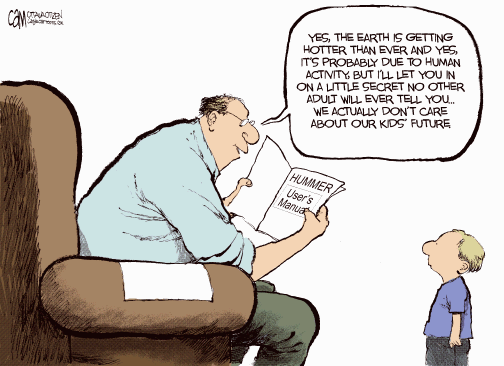In this lesson, we will investigate a combination of several different datasets and models in order to analyze the extent to which global climate is affected by human activity. We will discuss the short and long term consequences of global warming and try to quantify the uncertainties inherent in scientific measurements.

About Lesson 5
Lesson 5 will take us two weeks to complete. The topic here (also worthy of a course in itself) is recent climate change. My plan is to spend week one studying the data and observations related to climate change and then spend the second week thinking about models, theories, predictions, and discourse (scientific and political) based on those data and observations. I chose to break up this lesson in this manner because I think some of the misunderstandings about what is, and is not, known about recent climate change comes from a general public that is not literate when it comes to the task of distinguishing observations from models, and from scientists who use words such as "belief" and "uncertainty" without realizing that the general public interprets those words differently than scientists do.
The topics in lesson 5 are covered in a more rigorous semester-long fashion in Meteo 469, so if climate science interests you, that's a good course to take.
What will we learn in Lesson 5?
By the end of Lesson 5, you should be able to:
- Differentiate between data and models
- Predict short- and long-term consequences of global warming
- Quantify the uncertainties inherent in scientific measurements
- Define feedback mechanisms associated with climate systems
- Define the greenhouse effect and list greenhouse gases
- List causes and consequences of sea level rise
What is due for Lesson 5?
The table below provides an overview of the requirements for Lesson 5. Lesson 5 will take us two weeks to complete. 30 Oct - 12 Nov 2019
| Requirement | Submitted for Grading? | Due Date |
|---|---|---|
| Reading: "The Curse of Akkad" | No |
5 Nov (end of1st week) |
| Reading/Discussion: "Rapid Wastage of Alaska Glaciers and Their Contribution to Rising Sea Level" | Yes—posted to the "Alaskan Glaciers" discussion forum in Canvas | participation spanning 30 Oct - 5 Nov (1st week) |
| Problem set: Plot your own climate data | Yes—Submit this assignment to the "Keeling curve problem set" dropbox in Canvas | 5 Nov (end of 1st week) |
| Reading: "The Real Holes in Climate Science", "Fixing the communications failure", "Climate Confusion Among US Teachers", "Climate Change: Past as guide to the future," and "Global-scale temperature patterns and climate forcing over the past six centuries" | No---but necessary for the Teaching/Learning discussion |
12 Nov (end of the second week) |
| Problem set: Write your own climate lesson using the JCM | Yes—Submit to the "Java Climate Model" dropbox in Canvas | 12 Nov (end of the second week) |
| Discussion: "Teaching and learning about climate change" | Yes—posted to the "Teaching and Learning About Climate Change" discussion forum in Canvas | participation spanning 6 - 12 Nov (second week) |
Questions?
If you have any questions, please post them to our Questions? discussion forum (not e-mail). I will check that discussion forum daily to respond. While you are there, feel free to post your own responses if you, too, are able to help out a classmate.